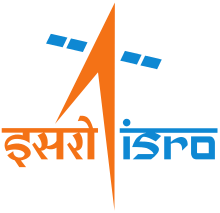Indian human spaceflight programme
The Indian human Spaceflight programme is a proposal by the Indian Space Research Organisation (ISRO) to develop and launch a two-person crew to low Earth orbit. Reports indicate that their human spaceflight will occur after 2017, on a GSLV-Mk III, as the mission is not included in the government's 12th five-year plan (2012–2017).[1] Since the ISRO does not have a human-rated launch vehicle or the budget from the government to undertake such a flight, it will not happen before 2020.[1][2]
India's First Manned Space Mission is being planned in 2021 by the Indian Space Research Organisation.[3][4][5] Dr K Radhakrishnan, Chairman, ISRO told this in an interview to NDTV.[6]
Preparations
On 9 August 2007 the then Chairman of the ISRO, G Madhavan Nair, indicated the agency is "seriously considering" a human spaceflight mission. He further indicated that within a year ISRO would report on its development of new space capsule technologies.[7]
Development of a fully autonomous orbital vehicle to carry a two-member crew into a low-Earth orbit (LEO) has already begun. ISRO sources said the flight is likely to be in 2016. Government had allocated ₹95 crore (US$14.1 million) for pre-project initiatives for 2007 through 2008. A crewed mission into space would require about ₹12,400 crore (US$1.8 billion) and a period of seven years. Planning Commission estimates that a budget of ₹5,000 crore (US$743.0 million) is required for initial work on the manned mission during the eleventh five-year plan (2007–12). A project report prepared by ISRO has been cleared by space commission.[8][9] In February 2009 the Government of India gave the green light for the manned space flight programme, due to launch in 2016.[10]
MC Dathan, director of Satish Dhawan Space Centre (SDSC) stated that ISRO will set up a full-fledged training facility in Bangalore for training Vyomanauts. ISRO is planning to build a third launch pad at Sriharkota for manned missions with extra facilities like entry into the crew capsule and an escape chute.[9]
The trials for the manned space missions began with the 600 kg Space Capsule Recovery Experiment (SRE), launched using the Polar Satellite Launch Vehicle (PSLV) rocket, and safely returned to earth 12 days later. This demonstrates India's capability to develop heat-resistant materials necessary for re-entry technology.
In 1984, Rakesh Sharma became the first Indian citizen to go into space, flying aboard a Soviet mission. Sharma was one of the people who endorsed the 2006 proposal for an Indian manned space programme.
Development

The major objective of this programme is to develop the fully autonomous three-ton ISRO Orbital Vehicle spaceship to carry a 2-member crew to orbit and safely return to Earth after a mission duration of a few orbits to two days. The extendable version of the spaceship will allow flights up to seven days, rendezvous and docking capability with space stations or with an orbital platform.
ISRO plans to use for OV spaceship the GSLV-Mk II launcher (Mark two is Geosynchronous Satellite Launch Vehicle-II launcher with an indigenous cryogenic engine). About 16 minutes after lift-off from the Satish Dhawan Space Centre (SDSC), Sriharikota, the rocket will inject the Orbital Vehicle (OV) into an orbit 300 km-400 km from Earth. The capsule would return for a splashdown in the Bay of Bengal.
The Indian Space Research Organisation (ISRO) will set up an Vyomanaut (astronaut) training centre in Bengaluru by 2012, to prepare personnel both for first orbital flights aboard an OV and for future manned Moon missions after 2020.
A site of 140 acres (0.57 km2) nearby the Kempegowda International Airport has been identified. The ₹1,000 crore (US$148.6 million) centre will train the selected Vyomanauts in rescue and recovery operations, operate in zero gravity environment, and monitoring of the radiation environment.
India would receive assistance in crew selection and training from Russia under an agreement signed between the two countries in March 2008. One option was a flight of an Indian Vyomanaut aboard a Soyuz capsule in preparation for the Indian mission. However, in October 2010 this option was discarded.[11]
ISRO will build centrifuges to train the Vyomanauts on the high-gravity acceleration which occur when the vehicle lifts-off. It also plans to build a new launch pad at a cost of ₹600 crore (US$89.2 million). It would be the third launch pad at the Satish Dhawan Space Centre on the east-coast in Andhra Pradesh, some 100 km north of Chennai.
In spring 2009 the full-scale mock-up of the OV crew capsule was built and delivered to Satish Dhawan Space Centre for training of Vyomanauts. India will be short listing 200 IAF pilots for this purpose. The selection process would begin by the candidates having to solve an ISRO questionnaire, after which they would be subjected to physical examinations like cardiac, dental, neurological, ophthalmologic, psychological, radiographic, and ENT. They will also have to undergo several laboratory tests at the Indian Aerospace Medicine in Bengaluru. Only 4 of the 200 applicants will be selected for the first space mission training. While two will fly, two shall act as reserve. The commencement of the selection process awaits government's approval.[12][13]
In October 7, 2016, Vikram Sarabhai Space Centre Director K. Sivan stated that ISRO is gearing up to conduct a critical 'crew bailout test' or 'Pad Abort' to see how fast and effectively the crew module of an intended space mission could punch out from the spacecraft safely in the event of an emergency.
Cooperation with Russia
India and Russia signed a memorandum of understanding on joint activities in the field of human spaceflight programme during the visit of Russian president Dmitry Medvedev to India in December 2008.
According to the accord, an Indian Vyomanaut will once again be part of a space mission on board a Russian spacecraft. This mission, tentatively scheduled for 2013, would have preceded a planned Indian manned spaceflight in 2016. This plan was abandoned later in 2010.[11]
Under the MoU signed by G. Madhavan Nair and his Russian counterpart Anatoly Perminov, ISRO and Russian space agency Roskosmos stated that they would jointly build the spacecraft for the Indian manned mission.
ISRO has already been awarded ₹95 crore (US$14.1 million) to study all aspects of the manned space mission, which will involve a two-member Indian crew spending a week in space. The spacecraft, to be placed in a low Earth orbit, will splashdown in the Indian Ocean after completion of the mission.
Terminology
- The term Aakashagami (meaning 'Sky Traveller'), is a literary word in Sanskrit, similar to the word 'Astronaut'.
- Brahmāndagami(Brahmānda-Space and Gami-Traveller) is another Sanskrit word literally meaning 'Space Traveller'.
- However, the designation Gaganaut, derived from Gagana (meaning 'The Heavens' or 'vast Sky above us'), has become popular amongst the Indian space community as a term for Indian astronauts.
- The term Antariksha Yaatri has been suggested as a more proper name (Antariksha signifies space beyond our Earth and Yaatri means 'Traveller'), and this is the name used in official documents, as well as the Indian media.
- Other suggestions include Vishvanaut (Vishva-World, this reality)
- Also,Brahmanaut (Brahmand-Universe).
- Having considered several terms, Vyomanaut has been finalised by ISRO. The term Vyomanaut stands for Vyoma which means Space or Sky in Sanskrit.
References
- 1 2 "India not to undertake human space flight before 2017: ISRO". The Economic Times. 17 September 2012. Retrieved 21 June 2013.
- ↑ "Cities". Deccan Chronicle. 21 June 2013. Retrieved 21 June 2013.
- ↑ "India's First Manned Space Mission in 2021". Retrieved 12 November 2014.
- ↑ Vishnu Som (12 November 2014). "India Will be Ready to Launch Manned Space Mission in a Few Years: ISRO Chairman to NDTV". NDTV.com. Retrieved 13 June 2015.
- ↑ Rahul Devulapalli. "ISRO: India working on manned flight mission". The Hindu. Retrieved 13 June 2015.
- ↑ "India's manned space mission likely by 2021". indiablooms.com. Retrieved 13 June 2015.
- ↑ "ISRO considering manned space mission: Nair". The Hindu. Chennai, India. 9 August 2007.
- ↑ "Eleventh Five year Plan (2007–12) proprosals for Indian space programme" (PDF). Retrieved 21 June 2013.
- 1 2 "ISRO plans manned mission to moon in 2014". Business Standard.
- ↑ "India announces first manned space mission". BBC. 27 January 2010
- 1 2 "Indian Cosmonauts will not Fly in Russian Soyuz". roscosmos.ru. 10 October 2010. Retrieved 8 November 2010.
- ↑ Model of space crew module ready, The Hindu, 2 May 2009
- ↑ "IAF developing parameters for India's manned space mission". The Economic Times. 28 December 2012. Retrieved 28 December 2012.
Sources
- India's Space Odyssey – by Raj Chengappa – India Today, pp 60 to 66 – 5 February 2007
- http://planningcommission.nic.in:80/aboutus/committee/wrkgrp11/wg11_subspace.pdf
- http://www.indianexpress.com/news/plan-panel-okays-isro-manned-space-flight/426945/
- http://m.thehindu.com/sci-tech/science/isro-gears-up-for-critical-crew-rescue-test/article9194536.ece
External links
- ISRO orbital vehicle record at Astronautix.com
- President Kalam’s vision: India will land on moon in August 2025
- Hindustan Aeronautics Ltd (HAL) has handed over the first ‘Crew Module Structural Assembly’ for the ‘Human Space Flight Program’ to ISRO's Vikram Sarabhai Space Centre (VSSC)
